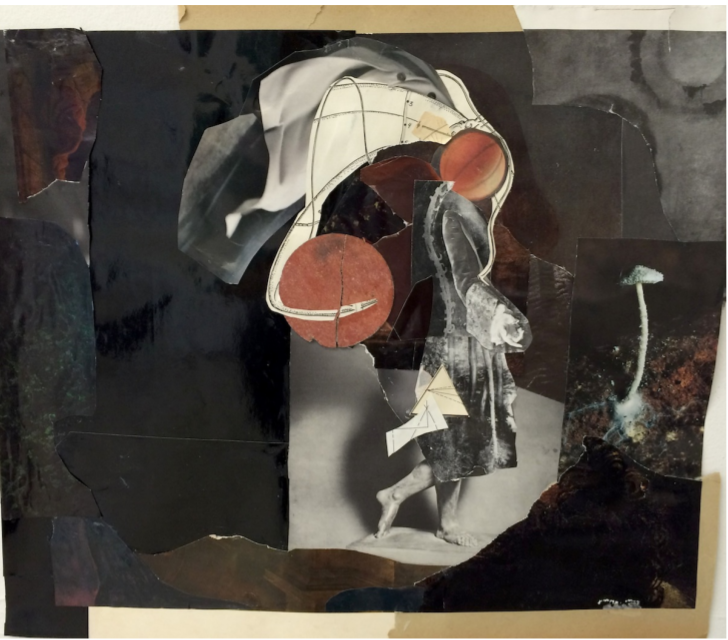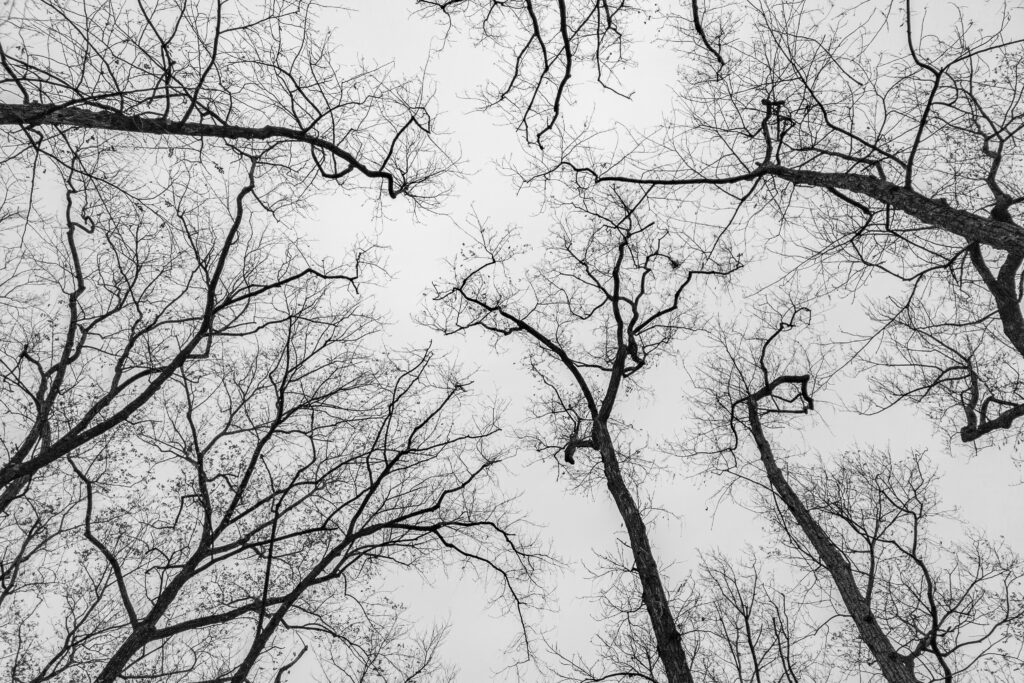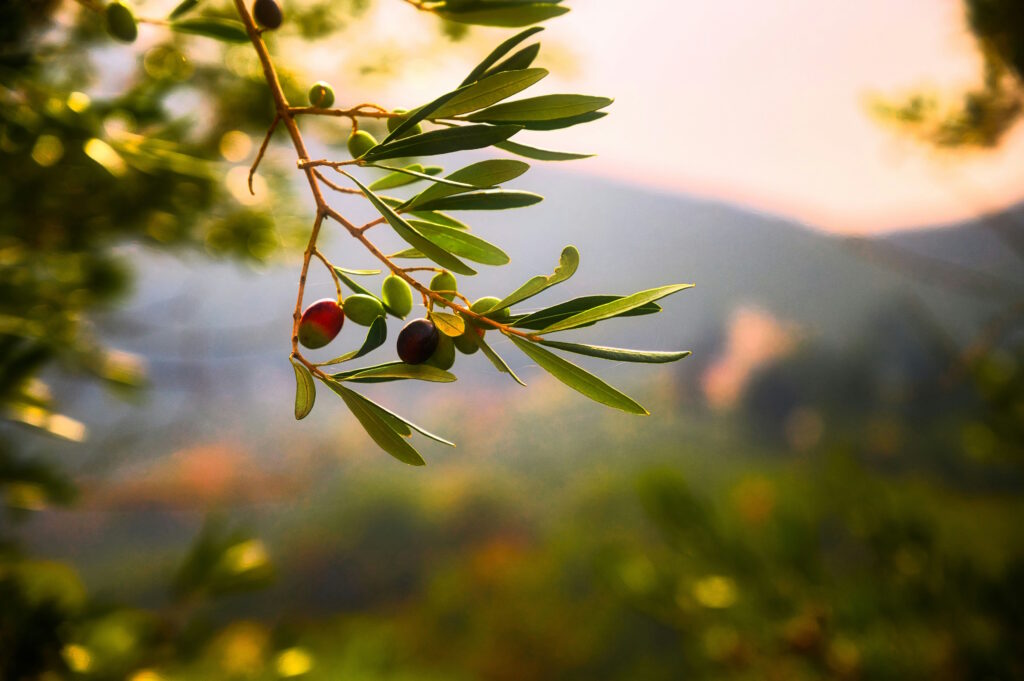The Feminine Mystique: A Micro-Interview with Kathy Bruce

“Women, Nature, and Evolution” by Kathy Bruce
Tapadas, Saints and Other Heroines is the winning work in Visual Art for the 2019 Editor’s Prize contest. In this microinterview, Caroline Frost and Tapadas artist, Kathy Bruce, meditate on the relationship between humans and the natural world, historical archetypes of women, the female form, and Kathy’s artistic influences.
In her artwork, Kathy Bruce explores archetypal female and mythological forms within the context of poetry, literature and the natural environment. I am generally drawn to collage’s pastiche nature, as well as its conservational mode through the repurposing of print media, but Kathy’s work especially intrigued me. Established interactions between female figures and the natural world juxtapose dated garments and other material objects, generating thoughts on historical social constructs that have determined the treatment and placement of women. Kathy has received the Nature Conservancy’s Nature is Everywhere Grant, the Fulbright-Hayes Senior Research-Lecturing Grant, and the Pollock-Krasner Foundation Fellowship Award, among many others. Her work has been featured in the Alexandria Quarterly, OSEF newsletter, Gasher Journal, Minding Nature Journal, and multiple articles, essays and anthologies. She currently resides in Upstate New York.
Caroline Frost: What catalyzed the series, Tapadas, Saints and Other Heroines?
Kathy Bruce: Many of my collages explore archetypal female forms inspired by the Peruvian saints, historical figures, and 16th century tapadas that I discovered during my early years as a Fulbright student scholar in Peru.“Tapadas” was the name designated to Limena women during the Viceroyalty of Peru and the early years of the Republic who wore shawls completely covering their body except for one eye. I find both the notion and the surreal image intriguing. The fashion was eventually outlawed by the Spanish authorities because it had a subversive effect on its intention—to protect and hide women’s bodies. However, the incognito coverings gave women the license to express themselves freely in society thus leading to flirtatious promiscuity.
The other women prevalent throughout the history of art in Peru are the saints—for example Santa Rosa de Lima, and, la Sarita Colonia, whose stories and images permeate contemporary Peruvian material culture in bizarre ways, (Key rings, bracelets, postcards, playing cards etc.) and the (perhaps) lesser-known remarkable Latin American women heroines such as Manuela Saenz, Sor Juana Inez de la Cruz and Clorinda Matto de Turner.

“Tapadas, Saints and Other Heroines”
Frost: What is the relationship between your paper work and your sculpture work, if any? What are some similarities and differences?
Bruce: Both are about building up structural forms to create a cohesive poetic vision. In the collages, of course, I can focus on significantly more detail and color than the large sculptures that by necessity require a broader treatment. Technically, I find myself working out the same issues in either 2-D or 3-D.
Now, returning to sculpture after months of lockdown where I made only collages, I find that the sculpture I am currently building reflects the Meninas figures in my collages over that time period. The subject of the sculpture is Queen Glumdalca from the 18th century English play by Henry Fielding, Tragedy of Tragedies, and is loosely based on the figures painted by Diego Velázquez in Las Meninas (1656). It will be a kind of sanctuary for birds. They seem to influence each other—not so much in aesthetic ways but philosophical ones.
Frost: How do you approach a new project? What’s your process like?
Bruce: The genesis of my collage work begins from a single photographic scrap. For example, the white marble forearm of a Canova figure. From there I build structures out from it, like constructing a sculpture, and add more photo bits and found scraps until the space around it has been developed into something distorted that represents the idea I am working on. At that point, the collage reaches its completion. I never work on a rectangular surface or sheet of paper. On the backside of the collages, you can see a myriad of paper fragments glued together like a patchwork quilt. (In this way, the collages are built like sculptures.)
The sculptures spark from an idea—sometimes I draw a stick figure in advance but most often I have a vision in my head of what I want to make and what I want it to look like. I don’t make models or drawings. They are site-specific installations that are built in situ outdoors as a response to the surrounding landscape and environment. I work with the premise of a female figure while contemplating the relationship of women to Nature in the process; the work starts as a conversation with its surroundings. A truly successful piece is one that melds into its setting which becomes apparent once the wildlife begins to merge with them, and they are overtaken by animals, birds, vegetation. The degenerative process, once a work begins to deteriorate back gently into the earth, is as important to me as the newly created work.
Frost: For you personally, what is the relationship of women to nature? And why do you feel it’s important to incorporate that relationship as a major theme throughout your oeuvre?
Bruce: As a woman, I am passionate about creating art that has the potential to generate a public awareness of our relationship as humans to the natural world. The specificity of gender calls attention to a biological understanding of the female form in relationship to the natural environment. What interests me is the way in which female figures correspond to structures in Nature: botanicals, trees, and landscape. This can manifest itself either internally or externally in the form of patterns, fashion, or metaphorical context to reveal the subtle yet enchanting similarities between the inner life of plants, trees, and humans.

“Beautiful, Deadly Flowers”
Frost: Are you influenced by any specific artists? Are there any artists you feel that you identify with?
Bruce: I would say that the most significant inspiration and source of influence on my work comes from the type of surrealism found in Latin American art, namely the Cuzco school of Spanish-Peruvian colonial art and after that, Mexican-Spanish colonial religious art. To me, these schools of painting are the richest in surrealist imagery in the sense that they miraculously subvert reality and Nature into unearthly transformations.
Frost: What’s your background?
Bruce: Growing up surrounded by Nature in Upstate New York, my parents were not artists but my grandmother allowed my sister and I artistic freedom. She piled her dining room table with mounds of construction paper where we spent hours assembling and gluing together paper collages. One of my earliest recollections is that around the age of 4, I mounted my artwork across the living room sofa and invited everyone to see the “exhibitions”. When I was 13, my family traveled across Europe and moved to Mallorca, Spain where we visited museums and architectural monuments; an experience that further triggered my passion for art and culture. I took painting classes from a local artist in Mallorca, and after high school, I studied initially at the school of Bellas Artes in Barcelona before returning to the States to attend the Pennsylvania Academy of the Fine Arts in Philadelphia and graduate school at Yale University.
Frost: What seminal events brought you to being an artist?
Bruce: The most important and transformative events were my experiences in Peru. As a Fulbright scholar, I traveled the countryside observing Peruvian Colonial folk-art and responded by creating small sculptures. This is where my love of “tapadas and saints and heroines” initially developed into a lifelong passion. Peru is a mysterious country for me; I am forever enthralled by the strangeness of visiting churches to view fragments of saint’s body parts in ancient reliquary boxes, random ugly dogs on the streets, and bones in Inca cemeteries that have been a continuous source of inspiration. Later, on a second Fulbright grant I spent 4 months teaching environmental art at the University of the Altiplano. My Fulbright senior research project involved working with a local Aymara artisan on Lake Titicaca. Using natural indigenous materials, we built a traditional totora reed fishing boat. Thereafter, armed with my newly acquired understanding of the totora reed, I built a twenty-five-foot high sculpture of totora reeds and bamboo of a double tailed mermaid based on the stone relief carved into the 17th century cathedral façade of a mermaid in Lake Titicaca.
Frost: Has your practice changed over time?
Bruce: To be able to draw together all my interests is satisfying. It took me years to synthesize my love for Latin America, Nature, Women, and History into individual art works drawing together various aspects of all these elements. As a result, tapping into this pool of spectacular resources makes creating artwork more exciting and magical than ever.

“Adaptive Behavior”


